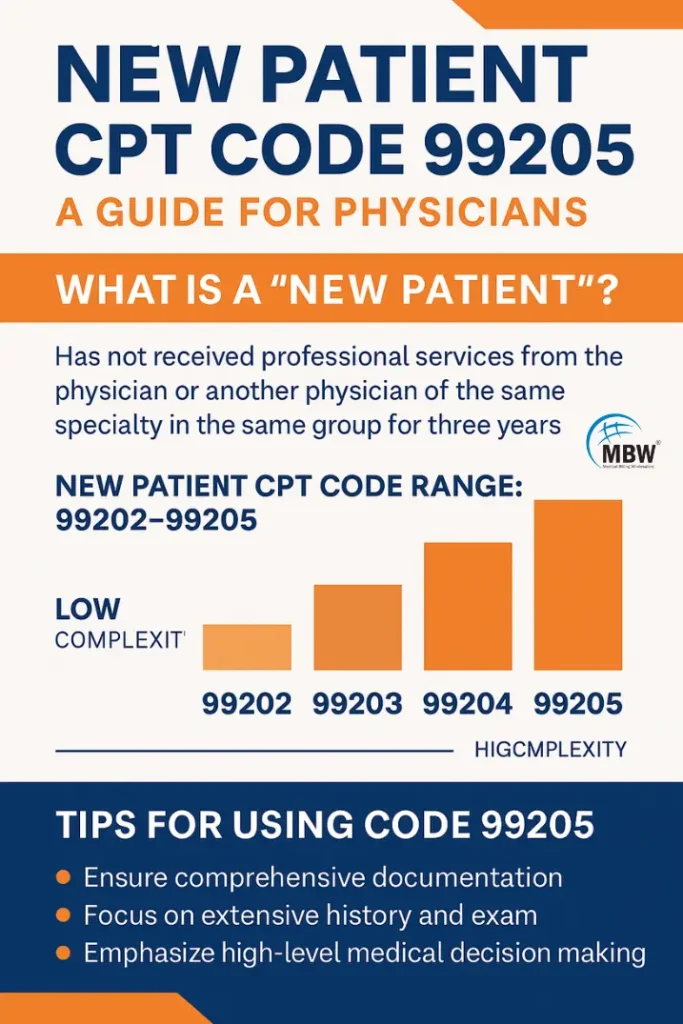Choosing the right new patient CPT code isn’t just about numbers—it’s about getting paid right and staying audit-safe. This guide makes 99202–99205 easy to understand so your first patient visits don’t turn into billing nightmares.

What Is a New Patient CPT Code?
A new patient CPT code represents billing codes used for documenting initial office or outpatient visits. According to CPT guidelines, a new patient has not received face-to-face services from the same physician or another provider of the same specialty in the same group within the past three years. Correctly applying the right code from 99202 to 99205 improves reimbursement, reduces claim rejections, and supports compliance.
Explore our detailed explanation of new patient CPT codes for more insights.
CPT Code Range: 99202 to 99205 Explained
The CPT code for new patient office visit has undergone important updates in recent years, shifting the focus toward medical decision-making (MDM) and away from rigid documentation checklists.
| CPT Code | Complexity | Time | MDM Level | Documentation Requirement |
|---|---|---|---|---|
| 99202 | Low | 20 min | Straightforward | Expanded history & exam |
| 99203 | Moderate | 30 min | Low | Detailed history & exam |
| 99204 | High | 45 min | Moderate | Comprehensive history & exam |
| 99205 | Very High | 60 min | High | Extensive history & exam |
For a practical breakdown of these codes with time-based documentation tips, visit our CPT code guide for new patient office visits.
CPT Code 99202
This is the entry-level CPT code for new patient visits. It’s used when the provider addresses straightforward issues that require minimal decision-making. Time spent is typically 20 minutes. Documentation should include an expanded problem-focused history and examination.
CPT Code 99203
A step up in complexity, CPT 99203 is appropriate for low-level MDM and a typical visit time of 30 minutes. The physician must document a detailed history and physical exam. It often applies to patients presenting with one or more self-limited problems.
CPT Code 99204
This code involves moderate-complexity medical decision-making and a visit duration of about 45 minutes. It requires a comprehensive history and exam, and is used when multiple management options are considered or when data interpretation is necessary.
CPT Code 99205
The most complex new patient CPT code, 99205 applies to encounters with high-risk patients requiring in-depth evaluation. It includes high-complexity MDM and at least 60 minutes of total time spent on the date of service. Documentation must support a comprehensive history, physical, and management plan, especially if time is used as the key factor.
How to Distinguish New vs. Established Patients
Understanding new vs established patient CPT rules is essential. A new patient hasn’t been seen within the last three years by the same specialty in a group, while an established patient has.
New patient codes require documentation of history, exam, and MDM.
Established patient codes need any two of the three components.
Role of Group Practice and Professional Services
The classification of a new patient CPT code depends on more than just time.
Group Practice
If a provider in the same group and specialty has seen the patient within the past three years, it’s considered an established patient.
Professional Services
Defined as face-to-face services billed with E/M codes. Non-face-to-face tasks like lab interpretations do not affect patient classification.
What Makes 99205 Stand Out?
CPT 99205 is the most complex new patient code. It involves:
Comprehensive history and exam
High-complexity decision-making
60 minutes total time on the date of the encounter
Due to its high reimbursement value, it’s frequently audited. Proper documentation must support the MDM level.

Practical Impacts of New Patient CPT Code Selection
1. EHR and Documentation Updates
EHR templates may need modification to reflect accurate time-based billing and MDM levels, especially for codes like 99204 and 99205. Learn how EHR changes in state law might impact documentation in Florida’s Amendment to Electronic Health Records Exchange Act.
2. Reimbursement Opportunities
Reimbursement increases with visit complexity. Providers selecting CPT code 99205 should be well-prepared with medical necessity documentation.
3. Coding Accuracy and Compliance
Incorrect use of new patient CPT codes can lead to claim denials or payer audits. Coding decisions should reflect the actual care delivered and MDM involved.
4. Patient Experience and Practice Efficiency
Accurate coding leads to more detailed assessments, timely reimbursements, and higher patient satisfaction.
Looking to streamline your revenue processes? Explore our RCM service offerings tailored for practices of all sizes.
FAQs About New Patient CPT Code
1. How do I determine if a patient is new for CPT billing purposes?
To apply a new patient CPT code, the patient must not have received face-to-face services from your group’s provider of the same specialty within the last three years. Reference our guide on new vs. established patient CPT classification for more.
2. Is CPT 99205 time-based, and how is time calculated?
Yes, CPT 99205 can be billed using total time spent on the date of service. This includes pre-visit review, face-to-face time, documentation, and care coordination. This flexibility supports accurate use of time-based CPT coding.
3. What documentation supports CPT 99205 for new patient visits?
To justify 99205, documentation must include a comprehensive history and exam, plus high-complexity MDM or at least 60 minutes spent. Ensure EHR templates capture all necessary details.
4. Can nurse practitioners or physician assistants bill new patient CPT code 99205?
Yes, advanced practice providers can bill CPT code for new patient office visit if services rendered and documented meet the code’s criteria and follow payer-specific guidelines.
5. Why are CPT 99205 claims often denied or audited?
CPT 99205 has a higher reimbursement rate, making it a target for audits. Inaccurate MDM levels or missing time documentation are common causes. Review our RCM compliance services to reduce risk.
Conclusion
Selecting the correct new patient CPT code not only impacts reimbursement but also compliance and patient satisfaction. By understanding the requirements of codes like 99205, practices can strengthen their revenue cycle and reduce audit risk.
Still unsure? Let our experts assist.
At Medical Billing Wholesalers, we decode complexity and deliver compliance. Whether it’s documentation, code selection, or payer policies—we’re here to help.
Talk to our CPT coding specialists and streamline your practice’s billing operations today.
